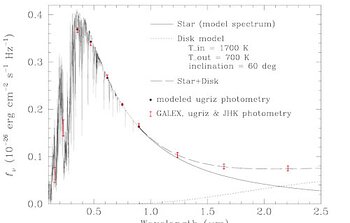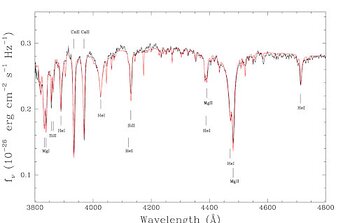A Ceres-like Dwarf Planet Swallowed by a White Dwarf Star
June 10, 2010

A Canadian-U.S. team led by Patrick Dufour (University of Montreal) discovered the most metal-rich white dwarf known to date by examining thousands of stars from the Sloan Digital Sky Survey. Their analysis, based on follow-up observations using the Gemini North telescope and the Multiple-Mirror Telescope (MMT), shows a clear signature of a tidally destroyed dwarf planet that once orbited the parent star.
White dwarfs are essentially dead stars that no longer have nuclear reactions in their core. Thus, they slowly cool off by simply radiating the remaining thermal energy left in the core at the end of their lives. They are also very compact objects with surface gravities on the order of 100,000 times larger than that of Earth. As a result, heavy elements sink rapidly toward the center of the star while light elements tend to float at the surface. Consequently, most white dwarfs are found to have nearly pure hydrogen or pure helium surface compositions. When heavy elements (calcium, magnesium, iron etc.) are detected in the outer layers of a cool white dwarf, their presence must necessarily be attributed to recent accretion episodes from an external source, most likely from small nearby asteroids that survived the earlier evolutionary phases of the white dwarf.
In a paper to be published in The Astrophysical Journal, Dufour et al. show that the star SDSS J073842.56+183509.6 is the most "polluted" white dwarf found to date, beating the previous record holder by a factor of 10. Using models of the structure and the atmosphere of this white dwarf, they show that the amount of material present at the surface of this object is about 4.3x1023 grams, close to the mass of the dwarf planet Ceres (9.4x1023 grams) which is the largest body in our solar system’s asteroid belt. Infrared photometry, taken with the Near-Infrared Imager (NIRI) on the Gemini North telescope, also revealed a large excess of infrared light that is best explained by the presence of an accretion disk around the star (geminiann10011a). This disk is believed to be the result of the tidal destruction of a nearby orbiting asteroid/planet feeding the surface of the white dwarf with heavy elements. Unfortunately, the mass of the disk cannot be determined at this point but it is likely to hold a similar amount of material to that present in the photosphere. Given this and the fact that an unknown amount of material has probably already sunk out of sight, it can be inferred that the object responsible for the extreme metal content observed in SDSS J0738+1835 was at least as large as Ceres, and perhaps even more massive.
Analysis of the spectroscopic data taken with MMT (geminiann10011b) also reveals that the chemical composition of the detected material is exceptionally similar to bulk Earth material, indicating that rocky planets similar to those in the solar system might be common. This discovery will offer a great opportunity, when higher resolution observations become available, for studying the composition of extrasolar objects with unprecedented accuracy.

